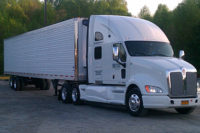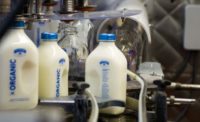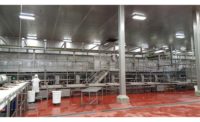Contessa Premium Foods' Green Cuisine processing plant is environmentally sound from all angles.

Image courtesy of Contessa Premium Foods
Contessa Premium Foods’ eco-consciousness is nothing new. Based at the Port of Los Angeles, this frozen seafood and entrée processor has used turtle-safe shrimp fishing methods and supported conservation and recycling efforts since President and Chief Executive Officer John Z. Blazevich founded the company in 1984.
But now the company’s name is almost synonymous with environmental awareness. That’s because this year Contessa completed the introduction of its brand new U.S. Green Building Council’s Leadership in Energy and Environmental Design (LEED) -certified processing plant in Los Angeles.
“Contessa believes environmental responsibility isn’t a choice. It’s a necessity,” says Vice President of Operations Dan Halford. “Our goal is to continue to find new ways to take care of the environment in every area of our business for the long-term sustainability of mankind.”
This goal is taken very seriously at the company’s Green Cuisine food plant, which officially began operations on Jan. 21, 2008. The 115,000-square-foot plant processes frozen entrees for retail, foodservice, private label and military channels. Included is Contessa’s Green Cuisine, a retail line of more than 31 frozen meal varieties. The company describes them as “easy-to-prepare meals with an Asian, Latin, American Home-style or Mediterranean influence.”
These meals live up to their “green” name by originating at the first LEED-certified frozen food processing plant in the world, a task made especially challenging because of the amount of energy typically used in a temperature-controlled environment.
“As a frozen food manufacturing plant that is totally temperature-controlled between zero and 40°F, it makes it more difficult to conserve energy, much less reduce it,” Halford says.
After starting the green plant project in May 2006, Contessa managed to meet all five LEED green facility criteria by October 2007. These criteria apply to the building’s materials and resources, water conservation, indoor environmental quality, sustainable site planning and energy conservation and environmental protection. In this case, Contessa:
- Sourced nearly half of all construction materials from the surrounding 500-mile area, reducing fossil fuel consumption and supporting the local economy;
- Outfitted the plant with waterless urinals, saving up to 200,000 gallons of water annually;
- Applied low emitting, volatile organic compound-free adhesives, paints, sealants, carpets and coatings throughout the plant;
- Developed a program that rewards employees who bike, carpool or use public transportation to get to work;
- Installed solar panels that cover 90 percent of the plant’s roof - the equivalent of two football fields. The panels are projected to save more than 730,000 lbs of carbon dioxide emissions per year;
- Saved energy throughout the plant through the use of motion sensors, natural light, increased insulation and energy-efficient lighting, heating and ventilation systems.
Not content with just putting “green” into practice at its own facilities, Contessa also encourages other food processors to consider taking steps to become more environmentally-friendly as well.
“Manufacturing accounts for 80 percent of industrial energy consumption and energy-related carbon emissions,” Halford says. “And while the food industry is essential for our very survival, it’s also the fifth largest consumer of energy in the manufacturing arena.”
Environmentally-conscious food processors may realize other benefits as well, he adds.
“Consumers are concerned about the state of the planet. Statistics show 49 percent of Americans intend on being more environmentally responsible. They prefer supporting businesses that offer green alternatives.”
At a glance
Company: Contessa Premium Foods Inc.
Food plant honored: Los Angeles
Selection criteria: Environmental initiatives
Employees: Approximately 200
Facility size: 115,000 square feet
Products: Frozen entrees
Executive Insights
Refrigerated & Frozen Foods talks with Vice President of Operations Dan Halford about Contessa Premium Foods' Los Angeles processing plant.
Refrigerated & Frozen Foods: Looking back on 2007, what are you most proud of?
Halford: Leading the Contessa team responsible for building the world's first energy efficient, Leadership in Energy and Environmental Design (LEED) -certified, frozen food manufacturing plant. Knowing that our state-of-the-art technologies are reinventing the food industry and contributing to the sustainability of our planet. For example, consider something as routine as trash. During the construction phase, only 25 percent of the waste ended up in a landfill. During plant operations we cut our waste disposal by 80 percent from our previous plant.
R&FF: What were the greatest challenges of the last year?
Halford: Earning our Gold-level certification from LEED. To earn LEED certification, a building project must meet specific requirements and performance benchmarks or "credits" within each of the five categories. Buildings receive Certified-, Silver-, Gold- or Platinum-level certification depending on the number of credits earned. Contessa surpassed Gold-level certification by 8 percent.This is the first time LEED worked with a frozen food manufacturer to certify actual plant operations versus an isolated office area. It was a daunting task, to reduce energy in a frozen food manufacturing plant, which is totally temperature controlled between zero and 40F.
R&FF: Talk about a few of your operation's strengths in relation to the "Food Plants of the Year" criteria. How did you develop these strengths?
Halford: Environmental responsibility and innovative processes are significant strengths. Contessa uses half the energy and reduces carbon dioxide emissions by 50 percent compared to a conventional plant its size built today. In addition, it is 100 percent carbon neutral. We developed these strengths by scrutinizing each and every process imaginable. We measured and analyzed our energy use, reduced it and redirected it where it was needed.
R&FF: What industry issues most trouble you in plant operations? What steps are you taking to address these concerns?
Halford: The human equation always is challenging. It is hard to find good people. That is why we are trying to automate as much of our operation as we can. However, when you have the diverse customers we do, it becomes difficult to service them properly with robots. Customization works more efficiently with the human touch. This is just one example of a Catch-22 at work.
R&FF: What are some of your key operational and other goals as you move forward through 2008?
Halford: To maximize our production efficiency by educating our entire workforce to "think green." And in this case, we mean so that everyone knows they are a profit center.


